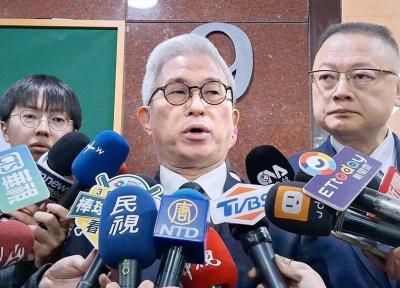Nuclear experts and a legislator yesterday criticized Taiwan Power Co (Taipower ) for its nuclear waste treatment during a visit to the Guosheng Nuclear Power Plant in New Taipei City’s Wanli District (萬里), saying the company’s temporary storage solution is problematic and its management is not transparent.
A visit by nuclear experts and activists to examine the plant’s dry cask storage facilities, a radioactive waste incinerator and a cooling pond was canceled after Taipower denied Japanese nuclear waste expert Masako Sawai access to the facilities due to a visa issue.
Sawai entered Taiwan exempt from a visa, but foreign visitors are required to hold a business visa to enter nuclear facilities, according to Taipower’s rules, which the group said the company deliberately hid from them when they filed Sawai’s application.
Taipower said visitors had been duly informed.
While the visit was canceled, former Institute of Nuclear Energy Research researcher He Li-wei (賀立維) was able to inspect the facilities.
Democratic Progressive Party Legislator Chen Man-li (陳曼麗) said the Legislative Yuan passed a resolution in 2014 to request Taipower revise its protocol for foreign visitors, which she said the company apparently did not do, adding that she would raise a motion to have the company do so immediately.
Despite not being able to personally examine the facilities, Sawai criticized Taipower’s dry cask storage based on its design.
The company plans to store high-level radioactive waste in steel cylinders surrounded by concrete shells placed outdoors as a temporary solution until a permanent depository is constructed.
“Instead of being constructed as a single and seamless piece, the steel cylinder is designed to be welded, but welding points might corrode and crack over an extended period, and the likelihood of corrosion is greater when casks are stored outdoors and exposed to winds containing sea salt,” Sawai said.
The casks should be portable, but Taipower’s concrete cask, each weighing about 200 tonnes, could not be transported in case of an emergency, Sawai added.
“Although concrete casks are 20 percent cheaper than the metal casks used in Japan and many European nations, safety is more important than costs,” she said.
Choosing a storage area that is at close proximity to sea was improper, because casks would be submerged during a tsunami, as was the case with the Fukushima Dai-ichi nuclear disaster, Sawai said.
He criticized the company’s incinerator for burning low-level nuclear waste. He said it runs on diesel instead of plasma torch technology as claimed on the Atomic Energy Council’s Web site.
Incinerators powered by diesel could only reach about 1,000?C, 90 percent lower than the temperature reached by plasma torch, leading to incomplete burning of radioactive waste, He said.
He also criticized the location of a cooling reservoir on a hill above the plant’s two reactors, which is designed to pump water to the cooling system using the force of gravity during a nuclear accident if electrical power is cut, saying that the reservoir was not placed high enough to have the pressure required to pump water into the reactors to prevent a possible meltdown.
“The improper design of the reservoir and incinerator arises from the fact that the designer and supervisor of the nuclear waste treatment are the same institution, which is the Atomic Energy Council’s Institute of Nuclear Energy Research. It is time for the council to be replaced,” he said.

Taiwan is to commence mass production of the Tien Kung (天弓, “Sky Bow”) III, IV and V missiles by the second quarter of this year if the legislature approves the government’s NT$1.25 trillion (US$39.78 billion) special defense budget, an official said yesterday. Commenting on condition of anonymity, a defense official with knowledge of the matter said that the advanced systems are expected to provide crucial capabilities against ballistic and cruise missiles for the proposed “T-Dome,” an advanced, multi-layered air defense network. The Tien Kung III is an air defense missile with a maximum interception altitude of 35km. The Tien Kung IV and V

The disruption of 941 flights in and out of Taiwan due to China’s large-scale military exercises was no accident, but rather the result of a “quasi-blockade” used to simulate creating the air and sea routes needed for an amphibious landing, a military expert said. The disruptions occurred on Tuesday and lasted about 10 hours as China conducted live-fire drills in the Taiwan Strait. The Civil Aviation Administration (CAA) said the exercises affected 857 international flights and 84 domestic flights, affecting more than 100,000 travelers. Su Tzu-yun (蘇紫雲), a research fellow at the government-sponsored Institute for National Defense and Security Research, said the air

A strong continental cold air mass is to bring pollutants to Taiwan from tomorrow, the Ministry of Environment said today, as it issued an “orange” air quality alert for most of the country. All of Taiwan except for Hualien and Taitung counties is to be under an “orange” air quality alert tomorrow, indicating air quality that is unhealthy for sensitive groups. In China, areas from Shandong to Shanghai have been enveloped in haze since Saturday, the ministry said in a news release. Yesterday, hourly concentrations of PM2.5 in these areas ranged from 65 to 160 micrograms per cubic meter (mg/m³), and pollutants were

Taiwan’s armed forces have established response protocols for a wide range of sudden contingencies, including the “Wan Chun Plan” to protect the head of state, the Ministry of Defense (MND) said today. After US President Donald Trump on Saturday launched a series of airstrikes in Venezuela and kidnapped Venezuelan President Nicolas Maduro, concerns have been raised as to whether China would launch a similar “decapitation strike” on Taiwan. The armed forces regularly coordinate with relevant agencies and practice drills to ensure preparedness for a wide range of scenarios, Vice Minister of National Defense Hsu Szu-chien (徐斯儉) told reporters before a